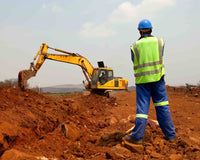5 Confined Space Safety Risks and How to Avoid Them

While the dangerous nature of confined spaces may not be as readily apparent as that of other kinds of workplace safety risks, tightly enclosed areas can, in fact, be fatal. One may encounter confined spaces in virtually any workplace or occupation. Larger industrial or agricultural worksites are particularly likely to contain confined spaces. And unlike other workplace risks that can be mitigated with personal protective equipment like work gloves or safety glasses, this danger requires an entire set of external gear. According to the Occupational Safety & Health Administration (OSHA), a space is “confined” if its configuration hinders the activities of employees who must enter, work in, and exit it. For instance, if employees must squeeze in an out or perform their tasks while cramped or contorted, certain risks may arise. The elements of confinement, limited access and restricted airflow, can result in hazardous conditions that would not occur in an open workspace. Identification of confined spaces, application of confined space equipment and recognition of the danger these areas pose is the first and most important step to preventing injuries and fatalities. The following are five of the most common and hazardous confined space safety risks.
1-Oxygen Deficiency
Asphyxiation is the leading cause of death in confined spaces, and a lack of oxygen within the space is the most common cause of confined-space asphyxiation. There is simply less oxygen available within any given confined space than in an open space, and hazards from this oxygen deficiency can occur when there are too many workers in the limited area at once or when a worker has been in the space for too long. Some confined spaces are so naturally oxygen-deficient that workers should not be in them for more than a few minutes at a time otherwise they risk serious safety issues. The proper ventilation products, like confined space blowers, should always be used in such environments.
2-Toxicity
The air in a confined space is sometimes be toxic, containing chemicals or fumes that may lead to deleterious health effects in the long or the short term. Alongside oxygen deficiency, a toxic atmosphere is the leading cause of asphyxiation in confined spaces. Hazardous vapors which might safely dissipate in open air may accumulate in a confined space, creating a harmful, high-risk atmosphere.
3-Getting Stuck
The cramped working environments that personnel in confined spaces face; the even smaller spaces within the confined space that they may have to squeeze through; and the physical contortions they often must put their bodies through can lead to getting stuck. Even where there is enough oxygen in a confined space to make working there safe for a set period of time, the low level of oxygen present relative to open spaces can mean that being stuck there for many hours can lead to oxygen deprivation. Additionally, there is the risk of slipping or falling into tight spaces, such as tapering discharge pipes in water towers, and asphyxiating from the resulting compression of the torso.
4-Uncontrolled Release of Energy
Often, a confined space exists parallel with other hazardous conditions. Risks such as the uncontrolled release of electricity, high-pressure fluids and gases, or mechanical energy often occur in confined spaces. Such uncontrolled releases are even more destructive in confined than in open spaces.
5-Risks from Failure to De-energize Equipment
Employees who work inside pieces of large equipment performing maintenance, repair or related tasks face a particular set of safety risks from the equipment itself. OSHA has documented many tragic incidents involving confined spaces in which victims were burned, ground up by auger type conveyors or battered by rotating parts inside mixers.
OSHA states that confined spaces that contain or have the potential to contain a serious atmospheric hazard such as those listed above should be officially classified as permit-required confined spaces. As such, they should always be tested for the presence of such atmospheric hazards prior to workers entering them. Once employees have entered a confined space, the space’s atmosphere should be continuously monitored to ensure that it remains safe. It is important that confined spaces be as well ventilated as possible in order to provide sufficient oxygen and discourage the accumulation of toxic gases. Employers should be mindful of coexisting hazards such as electrical energy, and should ensure that all equipment within the area is properly de-energized. A worker should never enter a confined space alone; there should always be a buddy or a monitor present. In the event of a confined space emergency, there should always be a rescue plan in place ahead of time. Perhaps most importantly, workers should only be in confined spaces for a restricted period of time.



